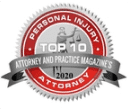Last Monday, a 23-year-old mother lost her life in a three-car accident involving a semi-truck in Lakeland. The deceased driver, Kaylie Cadwell of Lakeland, was heading southbound on Combee Road North. She collided with another vehicle, a Chevy Malibu, at the intersection of Combee Road and Old Combee Road when the Malibu unknowingly turned into Cadwell’s path. The collision spun Cadwell’s vehicle into the northbound lane of Combee Road North where it then collided with a tractor trailer, landing both vehicles in a ditch. Cadwell was pronounced dead at the scene.
Sheriff’s officials say that neither speed nor impairment were factors in the crash. The real culprit? Limited visibility. Dense fog was blanketing the area when the accident took place around 6:30 am.
As Floridians, we’re used to the torrential rains that limit our visibility during the summer months. Fog, on the other hand, is a less frequent occurrence that can catch us off guard. To avoid tragedies like the one above, there are a few extra precautions that every driver should take on those hazy mornings.
- Maximize visibility. Limited visibility means reduced reaction time. Make sure that other drives can see you by turning on your low-beams and making sure to use always use turn-signals. Otherwise, you could be putting yourself at risk for a rear-end or broadside collision. Inside the car, lower your windows or use your heater to negate any condensation caused by the fog inside your car. Before you leave the house, make sure your windshield is as clean as possible.
- Use the right lights. It might be tempting to use your high-beams in fog, but you’ll actually be doing more harm than good. The light beams from your brights reflect off the moisture particles in the fog, making it more difficult for the driver to see. Stick to low beams or use fog lights if your vehicle is equipped with them.
- Slow down. Since fog will be cutting down on your visibility and reaction time, make sure that you give yourself enough time to respond by driving at a more conservative speed. By going a bit slower, you’ll also give yourself more room in case the driver ahead of you stops short.
- Exercise extra caution. Drive under the assumption that other drivers will have trouble seeing you. Don’t drive aggressively, make unnecessary lane changes or impulsive maneuvers. Another helpful tip? Drive closer to the curb or other outer lane boundary in case cars in the adjacent lane fail to see the road markings and drift into your path.
If you feel too uncomfortable with your driving conditions, pull over. Put on your emergency flashers so that other cars can see you on the side of the road and keep your low-beams on for added visibility. Re-enter the roadway when the fog has lifted and visibility has returned.













